Mixing up gender roles, fusing old and new: the art of Hayv Kahraman
As the trees of Regent’s Park gradually turn from green to yellow, they herald the coming of the largest commercial spectacle of the arts calendar: the Frieze Art Fair. While visitors to the fair swarmed around the booths, I sat down with Hayv Kahraman, an Iraqi-born artist of Kurdish descent, currently represented by The Third Line in Dubai. Before us were mounted two of her most recent works, Curfew and Magic Lamp, both produced earlier this year and recently released in the commercial market. Impressively large and beautifully executed, they were markedly different in comparison to the other works that surrounded us at the fair, which, for its 13th year, had a rather cartoonish bent; perhaps this is the beginning of Frieze’s teenage years. On my way in, I passed a gathering of life-sized plasticine-like figures that had seemingly escaped from what looked like a children’s television programme set during a cocktail party in the 90s. Leaning in a corner was Mikhail Bulgakov’s Behemoth in the form of a towering and inflatable Felix the Cat. There were also a lot of rumpled, crumpled naked women. Kahraman’s work in comparison, however, boasted finely delivered figuration – not only unapologetically female and shamelessly lush in its decorative elements, but also referential to a visual heritage over 800 years old.
In search of inspiration, Kahraman’s research-based practice led her to the discovery of the Maqamat (Assemblies) of Al-Hariri, an illuminated Arabic manuscript produced in Baghdad detailing the picaresque tales of the wily Abu Zayd, and which dates back to the 12th century. Artists who would have worked in this tradition of book illustration in Baghdad had their practice violently cut short by the invasion of the Mongols in 1258. This idea of an ‘interrupted’ art fascinated her, as well as the feeling of a sense of loss with respect to the tradition of Arabic manuscript illustration.
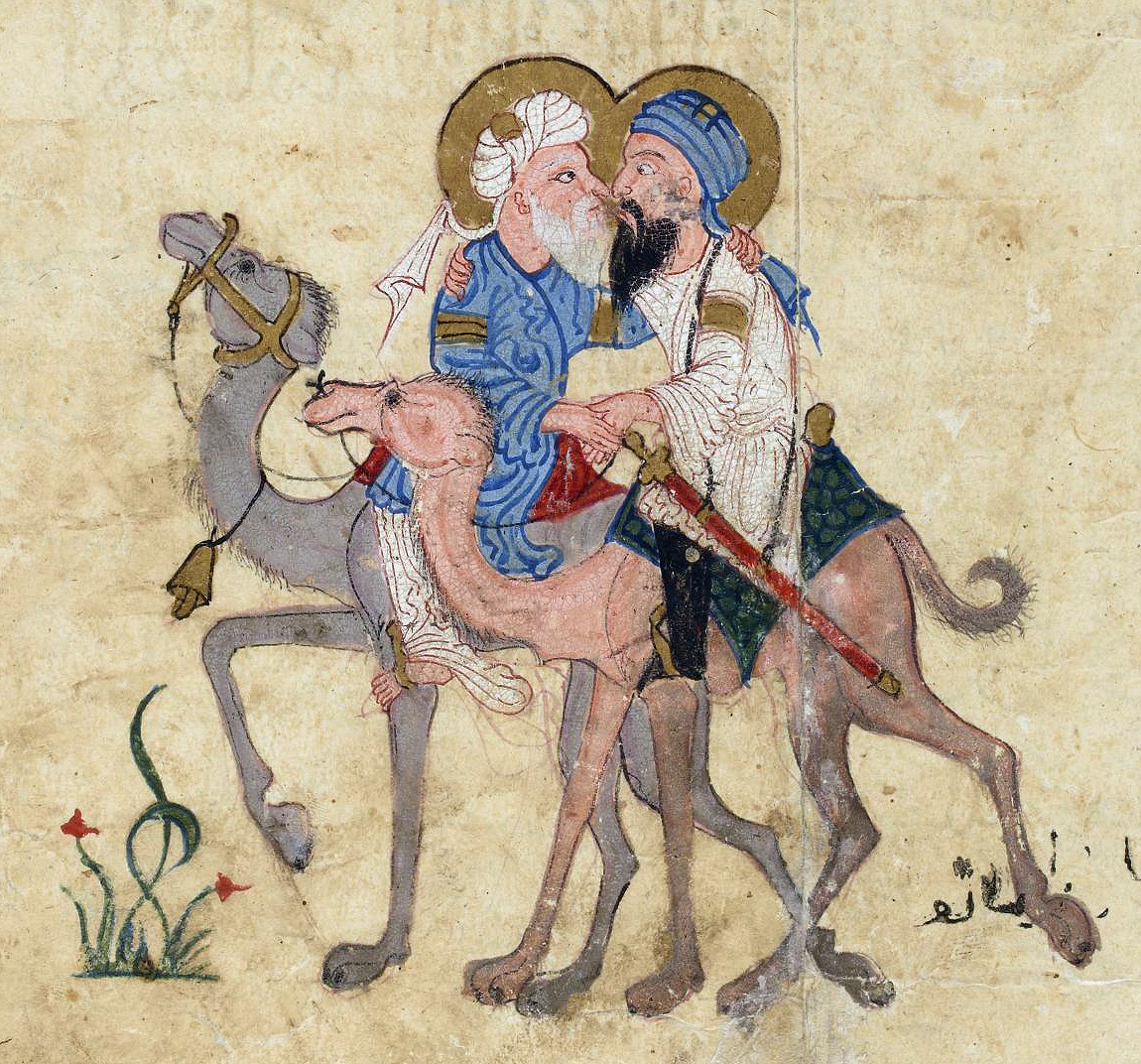
An illustration from Al-Hariri’s Maqamat, c. 1240 A.D.
Kahraman’s very approach to her work evokes the aesthetic of the past within the technological possibilities of the present. The linen for each of her canvases is imported from Belgium. Their colours vary; each year’s production is dependent on plants and the weather, and accordingly, her suppliers consistently provide her with a 2004 vintage, the shade of a very weak tea, chosen for its tonal similarity to vellum. Kahraman coats these in glue made from rabbit skin, a method inherited from the Renaissance. The technicality of her work is exquisite, and her practice meticulously organised. It is a characteristic, she says, left over from growing up in a warzone. Within the Third Line’s booth, the artist’s work was spookily foregrounded by the tiny warheads of Iranian artist Babak Golkar’s Monument to the Cold War.
What attracted Kahraman to the Maqamat, visually-speaking, was the unexpectedly sexually-explicit imagery – for example, in a graphic scene of The Hour of Birth, the head of the child emerging from the woman’s legs has disintegrated with time, while two men ride beside one another on camels, leaning across their steeds to kiss. ‘How explicit it was really appealed to me’, she said, noting the shared sense of warts-and-all honesty to her own approach to image making. ‘My early work was very literal and quite violent. My mother would look at it and exclaim, why are you making this!?’ The iconography of the two works shown at Frieze is even tamer in comparison to some pieces from 2008 now owned by the Saatchi Gallery, where metaphors for female vulnerability are heavily articulated as lambs flayed and sacrificed by elegant ladies in splendid, almost courtly dress. In retrospect, she admitted that the brutality of her images was reflective of the personal turbulence in her own life at the time. ‘I put nothing in my work that I haven’t myself experienced’, she asserted.

Collective Cut (courtesy the artist and Saatchi Gallery)
Born in Baghdad in 1981 during the early years of the Iran-Iraq War, Kahraman’s family relocated to Umea in the northernmost reaches of Sweden when she was 11. She had to navigate the dramatic change of scenery and language quickly, and attempts to make sense of her displacement as an immigrant are paramount in her work. It was an adaptation that incurred its own losses, as Kahraman gradually lost touch with her command of Arabic and her sense of Iraqi identity. The inspiration for the series exhibited at Frieze was a Facebook post that advertised a quiz to determine how ‘Iraqi’ she was, which informed the title. She ran through the questions, which ranged from benign polls about Iraqi cuisine to more alarming queries about experiences of conflict. A simple late-night trawl on social media presented her with a tragicomic take on displaced national identity. This was repeated when Kahraman came across blogs of nokat, Iraqi jokes. Again, humour became mixed with more unsavoury observations and an uncomfortable level of truth. The pieces in the series elicit the kind of laughter that makes one suck air through their teeth and hiss afterwards, as if they have just seen a child graze its knee. Kahraman read to me the text at the bottom of a work entitled Curfew:
A man joins the security forces in Iraq. He is given a gun and tasked to enforce a curfew at 11 pm, and to shoot anyone out at that time. At 10 pm, he sees a man and shoots him. His superior asks him why, as it is not yet 11. He replies, ‘oh, I know that man – there’s no way he would have been home in time, anyway’.
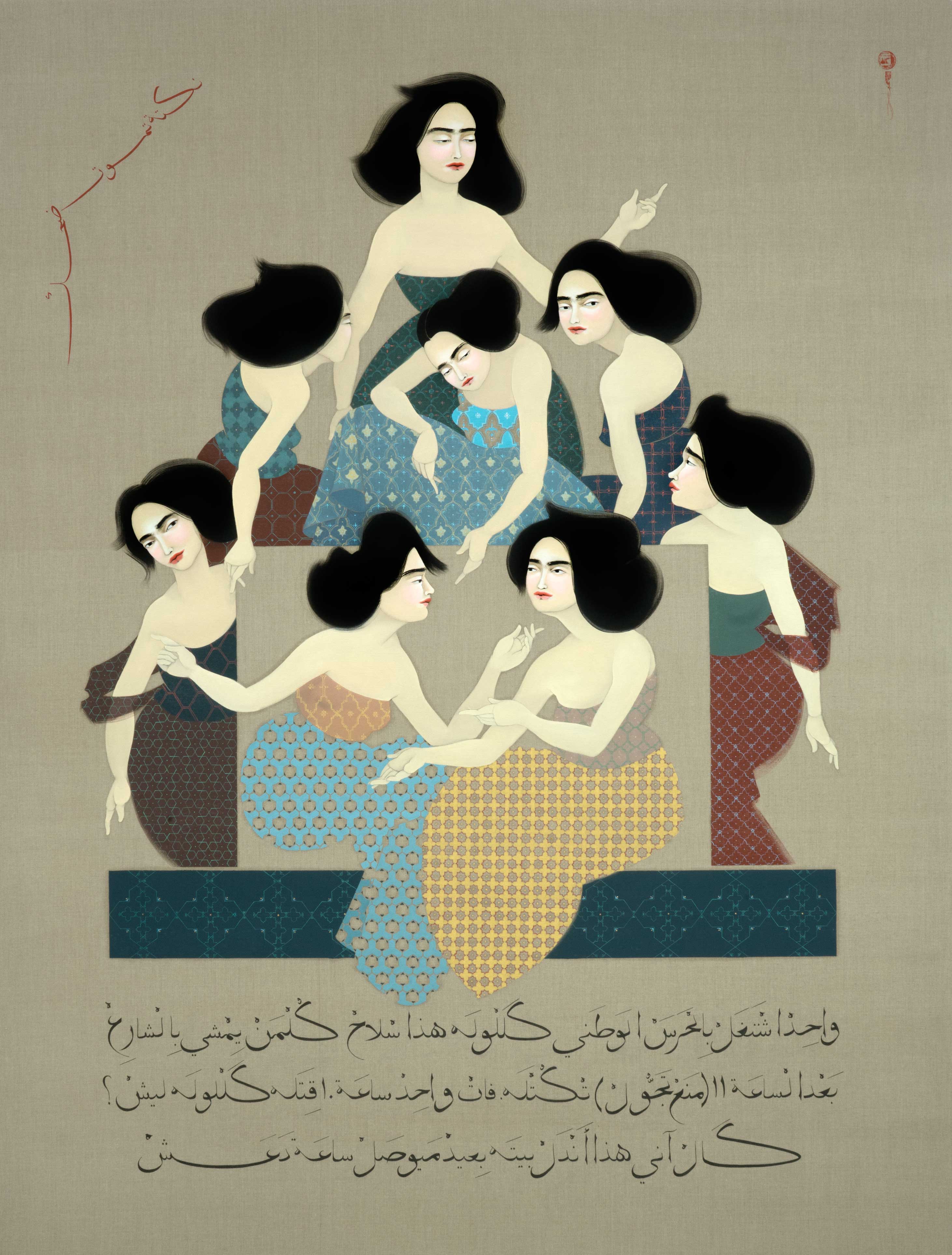
Curfew (courtesy the artist and The Third Line)
Each nokta passage is recounted in a colloquial Iraqi dialect. Their inclusion was part of Kahraman’s self-driven re-familiarisation with her mother tongue. She was keen to keep the script looking handwritten, so that it would retain its idiomatic informality. According to her, the narrative content of the Maqamat manuscript was also a source of inspiration for the reasoning and presentation of the text. A classic of Arabic literature, Al-Hariri’s book is a compendium of short stories about Abu Zayd, a sort of trickster who appears in different locations, situations, and guises. They illustrate the ordinary day-to-day activities of a medieval urban Arab world, which appealed to Kahraman’s desire to ‘archive a sense of the everyday’ in her own work.
By giving women primacy in visual representation while men are relegated to the bands of text at the bottom of her works, Kahraman’s way of shifting gender roles further reiterates the predicament of women so central to her work
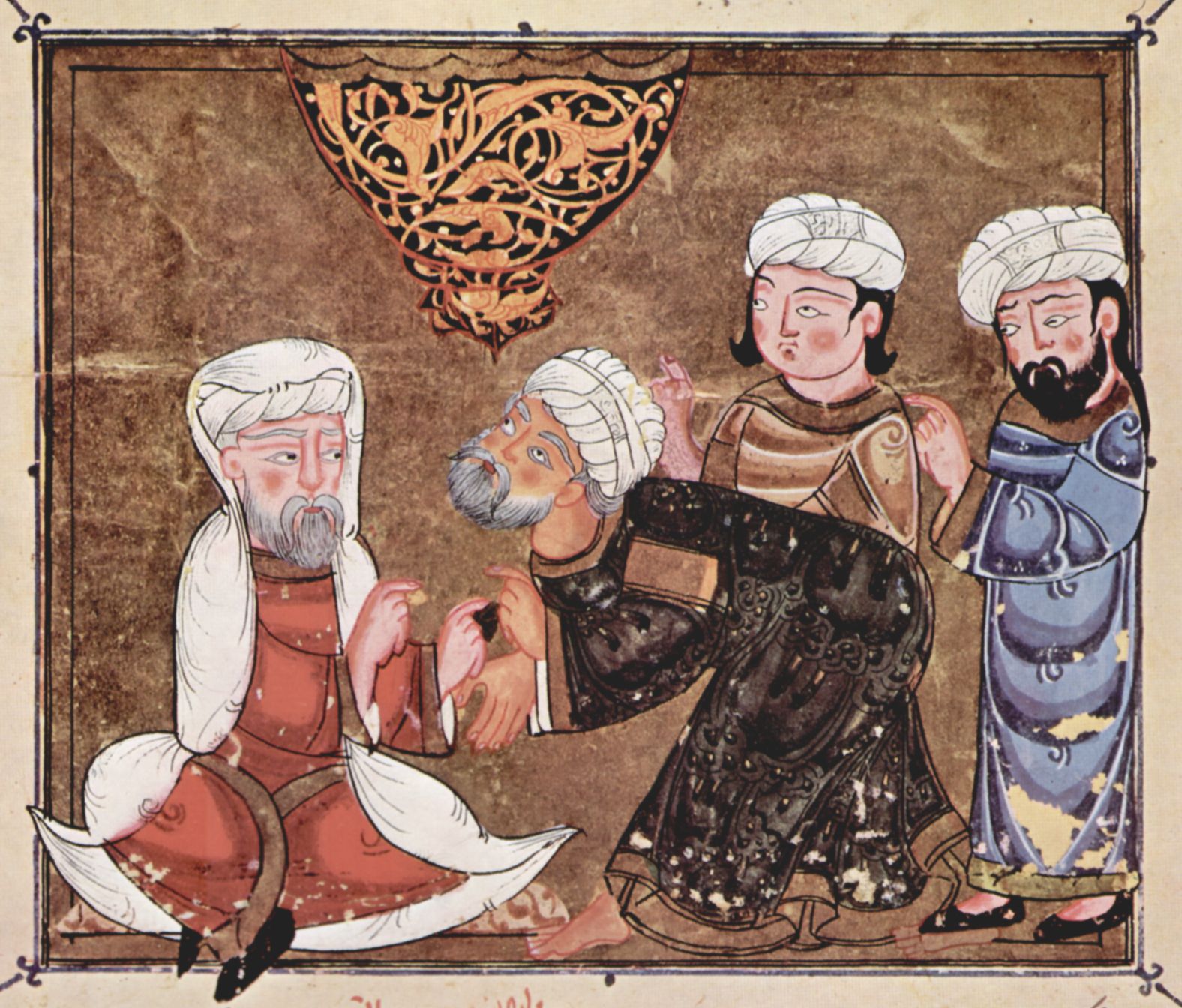
An illustration of an episode from Al-Hariri’s Maqamat set in Ma’arra (in present-day Syria), dated 1335 A.D.
I eavesdropped on two visitors to the booth, who remarked, ‘Well, if the images are of women, why is the text about men?’ This ambiguous approach to meaning in Kahraman’s series, where the relationship between text and images doesn’t directly correlate, has parallels to the experimental creation of album pages of muraqqa’ in Safavid Iran, Mughal India, and Ottoman Turkey. Albums of illustrations or calligraphic passages, muraqqa’ (whose name derives from the patchwork cloth of Sufi cloaks, and is, incidentally, semantically similar to maqamat) were separate from canonical texts and assembled in an ad-hoc fashion. Borders, calligraphic text, and images were pieced together in meticulous, experimental combinations whose didactic messages may have not been immediately obvious, and even deliberately oblique. Paintings of youths with wine flasks might have been reasonably paired with lines of poetry extolling divine love; however, when a seemingly unconnected parable was written underneath a tender line-drawing of an old yogi and his dog, viewers may have begun to scratch their heads. Instead, albums and their pages functioned as repositories, as sites of memory reflective of particular tastes or cultural moments. To attempt to read the dialogue between text and images in How Iraqi Are You? entails similar cognitive acrobatics, as tableaus of beautiful women hover over jokes about war and displacement; but, as with muraqqa’, their amalgamation is fixed in an instant of cultural deliberation. By giving women primacy in visual representation while men are relegated to the bands of text at the bottom of her works, Kahraman’s way of shifting gender roles further reiterates the predicament of women so central to her work.
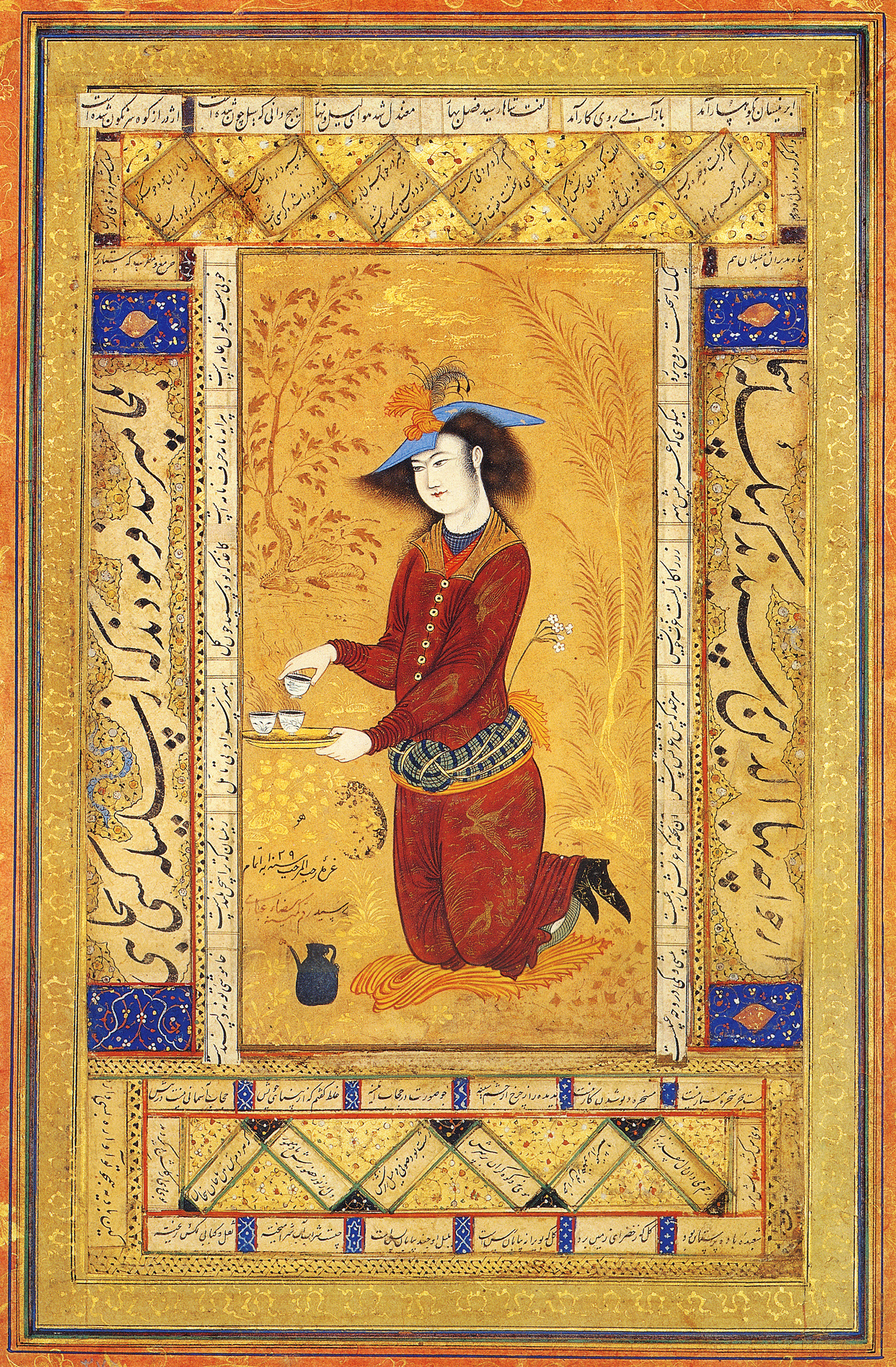
Muraqqa’ in an early 17th century Safavid-era Persian miniature by Reza Abbasi
Kahraman has also experimented with the feminisation of images initially of very masculine subjects. The initial source material for the composition of Curfew was a photograph of soldiers celebrating on the back of a pickup truck. A rectangle of negative space – what would have been the open cargo area of the vehicle – is now the background for a tumbling formation of female bodies gesticulating in conversation with gauzy dresses slipping off their shoulders, reducing and prettying the original scene. Magic Lamp possesses more explicit and formal similarities to the layout of the pages of the Maqamat, as the figures within are encased by thick borders, their limbs and skirts sometimes transgressing their boundaries. The weaving in and out of the two-dimensional flatness of the architectural elements that commonly divide the compositional space of the pages brings to mind the qualities of manuscript painting. There is also a similarity between the patterns and dresses worn by each woman and the architectural surfaces articulated in book illustrations. It is tempting to associate the women with ornaments, firmly situating them in the realm of the feminine and the domestic, but it is an interpretation at odds with the artist’s true intentions. ‘I constantly feel a need to create an agency for her’, she told me, turning the aforementioned connotation on its head.
Each woman is a self-portrait; Kahraman is her own model, and photographs herself in a variety of poses before committing them to canvas. How Iraqi Are You? began whilst Kahraman was pregnant with her daughter, and the artist hopes that the works will act as a gateway for her child to access a sense of heritage. When she was finishing the works, her newly-born accompanied her in the studio. ‘My daughter would look up at the paintings, zoning in on the faces’, she said. This remark was especially interesting in light of Simon Schama’s introduction to his new book on portraiture, wherein he muses on the science behind the degrees of facial recognition in a baby’s first few months of life. The deciphering of faces by babies, he says, is perhaps more immediate than we think. ‘Maybe she recognised those faces’, I told Kahraman, ‘because she knew they were yours’.
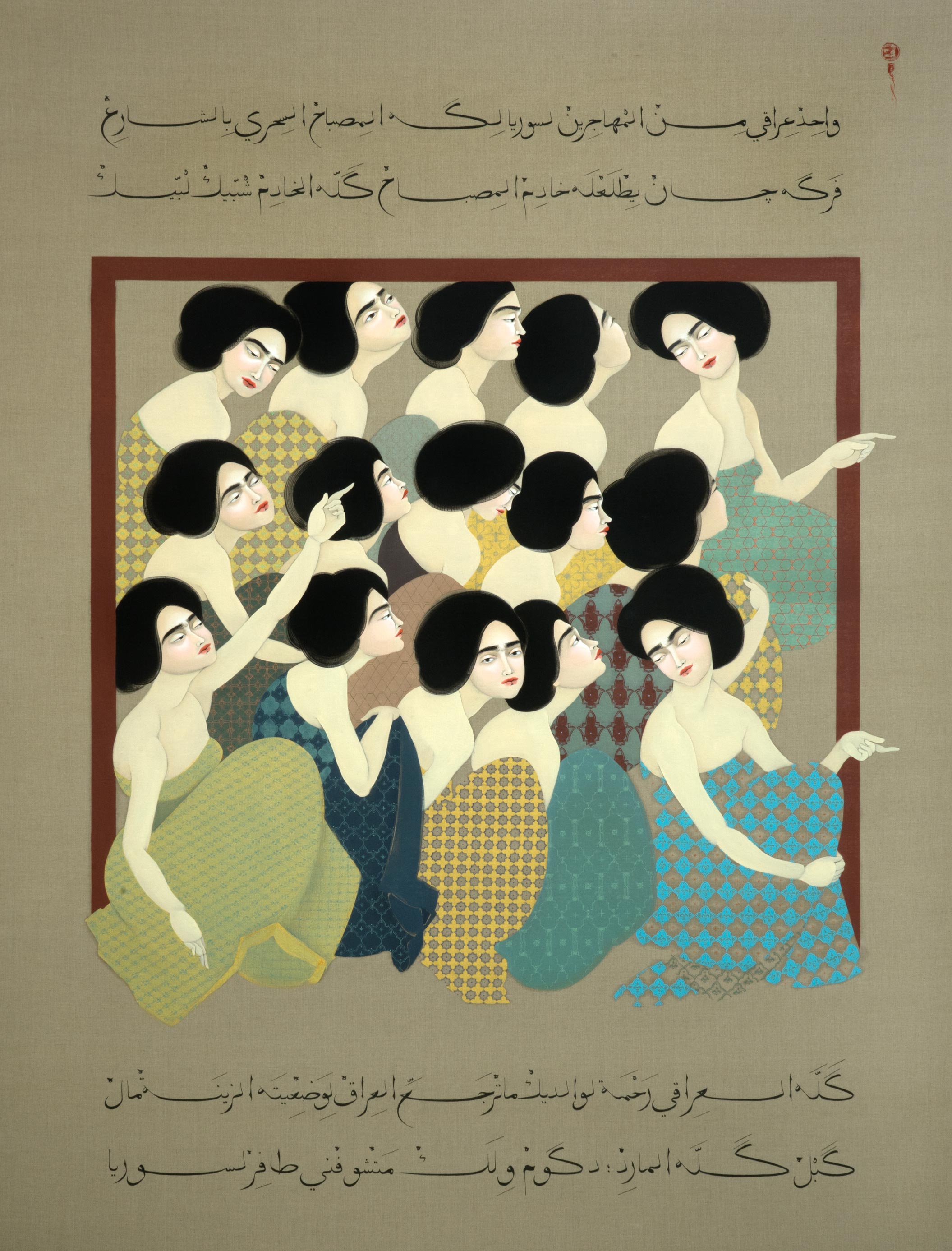
Magic Lamp (courtesy the artist and The Third Line)
The nokta at the base of Magic Lamp reads:
An Iraqi refugee in Syria found a magic lantern on the street. He rubbed it, and a genie came out and said, ‘Shobeek loobeek’ (Your wish is my command). The man said, ‘God bless you, sir. Could you return Iraq to its glorious old days?’ The genie replied, ‘Get me out of here! Don’t you see that I have come to Syria!?’
As newsreels struggle to keep up with the extent of Europe’s refugee crisis, Magic Lamp becomes a modern joke told in a medieval fashion with an unfortunate contemporary resonance. It speaks to those wrenched from their motherland, the reluctant transitions and perilous voyages undertaken by immigrants throughout history. People are born in places by happenstance, but ties to birthplaces and homelands stretch far beyond separations. Kahraman’s work is an exercise in strengthening such connections in the face of her own absence, navigating the pitfalls of her displacement with ingenuity and grace. And that, situated as it was in the grounds of such commercial hubbub, was priceless.
Cover image: DisEmbodied (detail; courtesy the artist and The Third Line).
Read interview online on REORIENT
